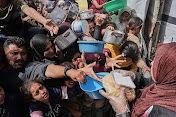These are the first RAF air strikes on Yemeni targets
approved by British government and the first direct participation in US-led
strikes since President Donald Trump came to power.
Defence Secretary John Healy said the strikes were successful
and carried out to protect British and international shipping.
"A
55% drop in shipping through the Red Sea has already cost billions, fuelling
regional instability and risking economic security for families in the
UK," Healy said in a statement.
The MoD said the strikes were conducted after it identified
a drone production facility located around 15 miles south of Yemeni capital
Saana.
It said the attacks were carried out using
"precision-guided bombs" after "very careful planning" to
hit targets "with minimal risk to civilians or non-military
infrastructure".
The strikes were carried out at night "when the
likelihood of any civilians being in the area was reduced yet further",
the MoD added.
The US military has been carrying out hundreds of attacks on
Yemen in recent weeks - claiming to have killed thousands of fighters, as well
as leaders of the group and commanders overseeing drone and missile production.
On Monday, Yemen reported at least 68 African migrants were
killed in a US air strike in north-western Yemen.
Since
November 2023, Houthis have targeted dozens of merchant vessels with missiles,
drones and small boat attacks in the Red Sea and the Gulf of Aden. They have
sunk two vessels, seized a third, and killed four crew members.
The Houthis are acting in support of the Palestinians in the
war between Israel and Hamas in Gaza, and have claimed that they are targeting
ships only linked to Israel, the US and Britain.
The Houthis were not deterred by the deployment of Western
warships in the Red Sea and Gulf of Aden to protect merchant vessels last year,
or by multiple rounds of US strikes on military targets ordered by former
President Joe Biden.
In
response to the most recent strikes, the Houthi authorities said the UK-US
attacks were in "support Israel's war and genocide in Gaza".
It added, "no matter
the challenges" the group will resist the "trio of evil" — the
US, Britain and Israel — and their allies.
In March, President Donald Trump ordered an intensification
of the US bombing campaign last month in response to Houthi attacks on Red Sea
shipping and Israel linked to the Gaza war.
The Trump administration says it is stepping up its attacks
on the Houthis. The US now has two aircraft carriers in the region.
US Defence Secretary Pete Hegseth recently criticized
European countries' response to Houthi attacks.
In a
recent leaked Signal chat with other senior officials, and giving details of
planned US strikes, Hegseth referred to Europe as "freeloaders" and
called their response "pathetic".

























